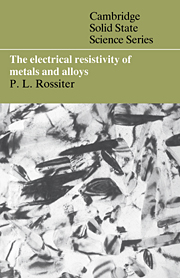Book contents
- Frontmatter
- Contents
- Preface
- 1 Basic concepts
- 2 Atomic configuration of an alloy
- 3 The structure of magnetic materials
- 4 Electrons in simple metals and alloys
- 5 Electrical resistivity of simple metals and alloys
- 6 Non-simple, non-magnetic metals and alloys
- 7 Magnetic and nearly magnetic alloys
- 8 Other phenomena
- Appendices
- References
- Index
6 - Non-simple, non-magnetic metals and alloys
Published online by Cambridge University Press: 07 January 2010
- Frontmatter
- Contents
- Preface
- 1 Basic concepts
- 2 Atomic configuration of an alloy
- 3 The structure of magnetic materials
- 4 Electrons in simple metals and alloys
- 5 Electrical resistivity of simple metals and alloys
- 6 Non-simple, non-magnetic metals and alloys
- 7 Magnetic and nearly magnetic alloys
- 8 Other phenomena
- Appendices
- References
- Index
Summary
The previous chapter was concerned with the electrical resistivity of simple metals and alloys. The result was a quantitative understanding of much of the behaviour associated with dilute and concentrated simplemetal alloys in terms of the electronic scattering processes and microscope phase distribution. Unfortunately there has been less progress in the understanding of non-simple metals and alloys. This is not especially due to any lack of a basic understanding of the processes concerned, but rather to the complicated nature of the techniques that are currently employed. In the case of simple metals the analysis was enormously simplified by the introduction of a weak scattering formalism. This was manifest at many different stages of the calculation: the approximate solution of the Boltzmann equation, the use of perturbation theory, the assumption of nearly free electrons and linear screening, for example. In alloys containing transition metals, however, the distinction between the valence and core states is no longer so clearcut. The d-states in the transition metals cannot simply be bundled into the core region and incorporated into some smoothly varying lattice pseudopotential. The wavefunctions associated with these states have significant amplitude outside the atomic core region and play an important role either by overlapping with those from adjacent atoms to form a narrow d-band or via the effects of hybridisation with the sp conduction bands. As a further consequence the Fermi surface may be quite irregular and have some parts that are s-like and others that are d-like.
- Type
- Chapter
- Information
- The Electrical Resistivity of Metals and Alloys , pp. 272 - 317Publisher: Cambridge University PressPrint publication year: 1987



